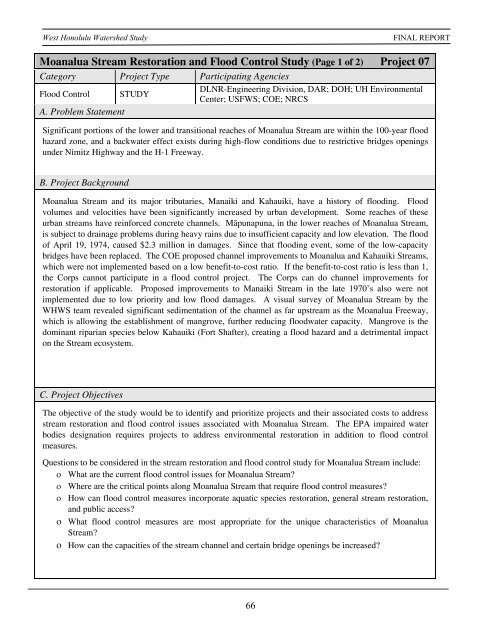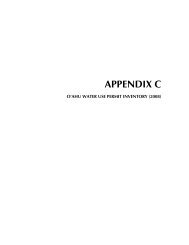West Honolulu Watershed Study - Final Report - Prepared for
West Honolulu Watershed Study - Final Report - Prepared for
West Honolulu Watershed Study - Final Report - Prepared for
You also want an ePaper? Increase the reach of your titles
YUMPU automatically turns print PDFs into web optimized ePapers that Google loves.
<strong>West</strong> <strong>Honolulu</strong> <strong>Watershed</strong> <strong>Study</strong> FINAL REPORT<br />
Moanalua Stream Restoration and Flood Control <strong>Study</strong> (Page 1 of 2) Project 07<br />
Category Project Type Participating Agencies<br />
Flood Control STUDY<br />
A. Problem Statement<br />
DLNR-Engineering Division, DAR; DOH; UH Environmental<br />
Center; USFWS; COE; NRCS<br />
Significant portions of the lower and transitional reaches of Moanalua Stream are within the 100-year flood<br />
hazard zone, and a backwater effect exists during high-flow conditions due to restrictive bridges openings<br />
under Nimitz Highway and the H-1 Freeway.<br />
B. Project Background<br />
Moanalua Stream and its major tributaries, Manaiki and Kahauiki, have a history of flooding. Flood<br />
volumes and velocities have been significantly increased by urban development. Some reaches of these<br />
urban streams have rein<strong>for</strong>ced concrete channels. Mäpunapuna, in the lower reaches of Moanalua Stream,<br />
is subject to drainage problems during heavy rains due to insufficient capacity and low elevation. The flood<br />
of April 19, 1974, caused $2.3 million in damages. Since that flooding event, some of the low-capacity<br />
bridges have been replaced. The COE proposed channel improvements to Moanalua and Kahauiki Streams,<br />
which were not implemented based on a low benefit-to-cost ratio. If the benefit-to-cost ratio is less than 1,<br />
the Corps cannot participate in a flood control project. The Corps can do channel improvements <strong>for</strong><br />
restoration if applicable. Proposed improvements to Manaiki Stream in the late 1970’s also were not<br />
implemented due to low priority and low flood damages. A visual survey of Moanalua Stream by the<br />
WHWS team revealed significant sedimentation of the channel as far upstream as the Moanalua Freeway,<br />
which is allowing the establishment of mangrove, further reducing floodwater capacity. Mangrove is the<br />
dominant riparian species below Kahauiki (Fort Shafter), creating a flood hazard and a detrimental impact<br />
on the Stream ecosystem.<br />
C. Project Objectives<br />
The objective of the study would be to identify and prioritize projects and their associated costs to address<br />
stream restoration and flood control issues associated with Moanalua Stream. The EPA impaired water<br />
bodies designation requires projects to address environmental restoration in addition to flood control<br />
measures.<br />
Questions to be considered in the stream restoration and flood control study <strong>for</strong> Moanalua Stream include:<br />
ο What are the current flood control issues <strong>for</strong> Moanalua Stream?<br />
ο Where are the critical points along Moanalua Stream that require flood control measures?<br />
ο How can flood control measures incorporate aquatic species restoration, general stream restoration,<br />
and public access?<br />
ο What flood control measures are most appropriate <strong>for</strong> the unique characteristics of Moanalua<br />
Stream?<br />
ο How can the capacities of the stream channel and certain bridge openings be increased?<br />
66



